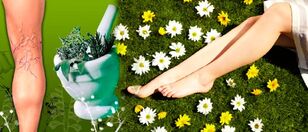
Treatment of varicose veins on the legs at home can be carried out by traditional medicine. Proper preparation and use of medications will help normalize venous function, blood consistency and metabolism.
What is varicose veins
Varicose veins are a disease of the vascular system, which is accompanied by dilation, dilation and modification of the veins. The consequence of the pathology is a violation of the blood flow, a reduction in the performance of the venous valves or a complete suppression of functions.
Veins are responsible for transporting blood from tissues and organs to the heart. When venous valves are destroyed or damaged, the blood stagnates and does not have the ability to fully climb the veins. In most cases, varicose veins are prone to lower extremity veins. The disease develops transiently due to the fact that the patient is in a flat position on his feet for a long time, and blood fills the veins.
Pathology is manifested by the appearance of a venous pattern above the surface of the skin. The veins become blue, green, blue or purple. The shape of the veins depends on the severity of the disease. In advanced cases, the veins twist, swell and have nodular formations.
According to statistics, women are several times more likely to have varicose veins. This is due to pregnancy, family predisposition, hormonal instability. The disease occurs in patients older than 30 years.
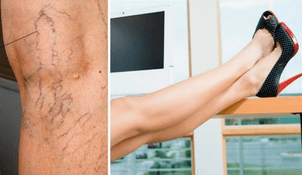
Causes of varicose veins
Varicose veins develop in the background of loss of elasticity of the vein walls, which further leads to valve disorders. The elasticity of the vein walls is lost due to the imbalance of collagen and elastin in the patient’s body. The reasons for this process cannot be determined, but some risk factors that lead to varicose veins have been identified.
The following factors can cause pathology:
- Pregnancy. Carrying a fetus is accompanied by an increased venous load. The pelvic area may be restricted in full blood flow due to pressure on the veins by the growing fetus, due to an increase in the amount of water.
- Hormonal instability, taking oral contraceptives. Human hormonal levels are of great importance for overall health. Violations can cause a breakdown in the production of elastin and collagen, the development of thrombosis.
- Sedentary lifestyle. This factor affects patients whose work requires
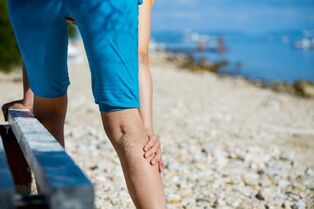 to be in one position for a long time (office workers, cooks, salespeople). The valves stop coping with their functions, and the blood stagnates in the lower extremities.
to be in one position for a long time (office workers, cooks, salespeople). The valves stop coping with their functions, and the blood stagnates in the lower extremities. - Excessive physical exertion. The disease affects men and women whose activities are related to sports, hard work. With prolonged physical exertion, the intra-abdominal pressure increases, which causes a decrease in the tone of the veins of the lower extremities, stagnation of blood in the veins.
- Overweight, low body weight. Significant deviations of weight from the norm cause metabolic disorders. Excessive weight creates great stress on the veins of the lower extremities. The valves work in an improved mode and wear out quickly.
- Bad habits. Alcohol and tobacco contain a lot of harmful substances, carcinogens. Prolonged exposure of the body to cigarettes and alcohol leads to an increase in blood density. Further, the vessels lose elasticity, weaken, thrombosis and varicose veins are formed.
- Diabetes mellitus. The disease adversely affects the blood vessels, causing a predisposition to venous pathologies, thrombosis.
- Genetic predisposition. There is a gene that is responsible for the structure of muscles and connective tissue. If this gene has undergone a mutation in one generation, then it is passed from parent to child.
Attention!
Varicose veins can develop by wearing uncomfortable shoes, tight and tight clothing on a regular basis. Modern living conditions, improper diet leads to an increase in the number of patients with varicose veins.
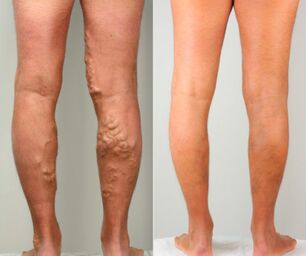
Stages of varicose veins in the legs
Varicose veins have 4 stages of development. The patient needs medical help from the first phase. But, 90% of patients turn to a specialist when the second and third stages of the disease appear.
The symptoms of the disease depend on the severity of the pathology:
| Phase | Description | Symptoms |
| 1. Fee | The initial phase, which has no pronounced symptoms. Circulatory disorders have not yet appeared, but there is a large load on the walls of the veins. The duration of the phase is from 3 months to 5 years. |
|
| 2. Subcompensation | At this stage, patients usually visit a specialist. The blood flow in the legs is disturbed, the valves do not cope with their functions. The subcompensation phase requires mandatory medical care to prevent serious consequences and complications of the pathology. |
|
| 3. Decompensation | Large amounts of blood accumulate in the veins of the lower extremities. The stage is complicated by the risk of trophic ulcers. |
|
| 4. Last | The fourth stage of varicose veins is dangerous with a fatal outcome. Against the background of the development of pathological changes in the small and large veins, there is a high risk of heart attack. |
|
If the patient experiences rapid leg fatigue, it is advisable to pay attention to the problem. This may be the first sign of the development of varicose veins.
Treatment with folk remedies
Treatment of varicose veins with traditional medicine can be carried out only after the approval of the attending physician. Home remedies have some advantages - cheapness, few side effects. Fats, compresses, tinctures and juices from a combination of various herbs are used against varicose veins.
Tinctures
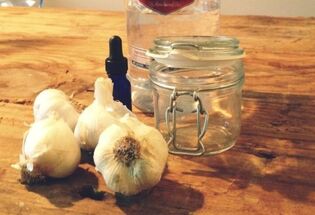
Tinctures are prepared on the basis of ethyl alcohol. The advantage of alcohol is the ease of transport, long shelf life and the ability of ethanol to detect biologically active substances.
Popular tinctures in the treatment of varicose veins:
- Garlic tincture. To prepare you will need 150 g of peeled garlic, 20 ml of high quality vodka, 40 g of honey, 90 ml of propolis extract for alcohol. Chop the garlic with a blender and add the vodka. Let it cook in a dark place for 2 weeks. Then strain the substance through gauze. Add honey and propolis extract to the purified solution. Put the tincture in the refrigerator for 3 days. Start taking the medicine with 1 drop before meals. Next, increase the dose by 1 drop with each meal. When you reach 25 drops, start reducing the dosage by 1 drop with each dose. After completion of treatment, the course can be repeated after a month.
- Nutmeg tincture. To prepare you need 50 g of chopped nutmeg and 250 ml of vodka. Mix nut powder with vodka, shake and leave to infuse for 2 weeks. Take 20 drops, diluted in water, 3 times a day.
- Lilac tincture. To prepare the remedy, you need to mix 1 cup of lilac flowers with 1 cup of vodka. Let the product stand in the cold for 1 week in the refrigerator. Then strain the medicine and store in a dark, cool place. Take 1 tablespoon 2 times a day 30 minutes before meals. The course of treatment is 1 month.
Attention!
Tinctures are contraindicated for people with ethanol intolerance, alcohol dependence, renal and hepatic insufficiency, diseases of the gastrointestinal tract.
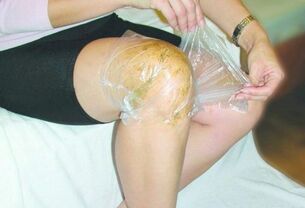
Compress
A compress is a bandage with a medicinal solution that is applied to the affected area of the body for a certain period of time. When using the method against varicose veins on the legs, it is necessary to exclude the presence of skin damage.
Alternative medicine offers the following types of dressings:
- Honey. Prepare a large gauze bandage, apply a thin layer of lime honey and wrap the leg. Wrap 1 layer of cling film and an elastic bandage on top. Keep the compress on your feet for no more than 30 minutes. Apply once in 2 days. The course of treatment is 2 weeks. If necessary, it can be repeated after 30 days.
- Important. Pour 1 liter of room temperature water into the basin, add 4-7 drops of essential oil (pine, lavender or orange). Soak a gauze bandage well in the solution and wrap your leg. The duration of therapy is 20 minutes. The course of treatment is 10 days.
- Grapes. For cooking you need 300 g of seedless grapes, 5 tbsp. spoons of apple cider vinegar. Grind the grapes and mix with the apple cider vinegar. Allow the product to infuse for 4 hours. Then apply the consistency to the gauze bandage and wrap the leg. The compress should be on the painful part of the limb no more than 20 minutes a day. The course of treatment is 2 weeks.
Attention!
Before using the dressing, you must make sure that you are not allergic to the components included in the preparation of the medicine. Properly prepared compress helps reduce pain, swelling, nourishes and regenerates the skin.
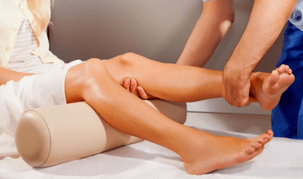
Rubbing
Rubbing against varicose veins is used at any stage of the disease. The means for the procedure are easy to use, they can improve skin regeneration, to tone blood vessels.
There are the following recipes for rubbing varicose veins:
- Apple cider vinegar. It can be bought in the store. Use only 6% vinegar for treatment. The procedure consists of rubbing the areas of the legs where there are spider veins or bulging veins. Do not apply to the surface of trophic ulcers and cracks on the skin.
- Lemon. It is necessary to peel a fresh lemon from the peel and rub the areas of the lower extremities affected by varicose veins. Ensure skin integrity before use.
- Horse chestnut tincture. Prepare 1 cup chopped wild chestnuts. Pour into a three-liter jar and pour 1 liter of vodka. Let it cook for 30 days in a cool, dark place. Then strain the tincture and rub your feet 3 times a day.
It is not recommended to apply rubbing while using ointments or compresses against varicose veins. Excessive skin exposure can cause severe burns, irritation and pathology complications.
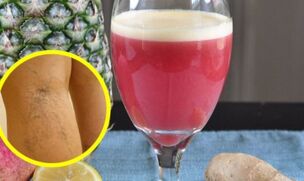
Drinks
It is necessary to adhere to the drinking regime during the treatment of varicose veins. An adult should drink at least 1. 5 liters of water a day (in the absence of kidney problems).
In addition to water, you can drink the following drinks:
- Green tea. Promotes blood thinning and dissolving clots. Vitamin E and polyphenol in tea tone and nourish blood vessels.
- Juices, fruit drinks from sea buckthorn berries, mountain ash and black currant. It contains vitamins A, B, C which nourish the veins, normalize blood flow and tone the vascular walls.
- Carrot, pumpkin and cranberry juice. Reduces swelling of the legs, activates metabolism in vascular tissues.
- Fruit compote with a high proportion of apples. It provides the body with vitamins and minerals that are necessary for normal metabolism, the work of the cardiovascular system.
Exclude coffee, alcohol and carbonated water from your drinks at the same time.
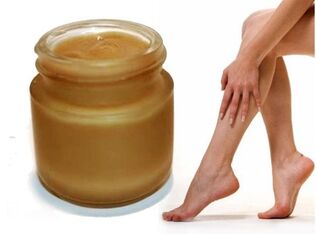
Fat
Ointment against varicose veins can be used only in the early stages of the disease. It is forbidden to use the product in case of cracks, trophic ulcers on the skin. Properly prepared product helps prevent the inflammatory process on the walls of blood vessels, strengthens and tones the veins, reduces swelling and slows down the process of thrombus formation.
Recipes for making ointments against varicose veins:
- Of marigold flowers. You will need 1 cup of lard, 0, 5 cups of dried marigold flower. The ointment must be melted in a water bath, mixed with a marigold flower. Boil for 2 minutes, then pass the mixture through 2 layers of gauze. Pour the resulting mixture into a small glass jar made of dark glass and place in the refrigerator. Apply to the affected areas in a thin layer once a day, preferably at night. The course of treatment is 2 weeks.
- Garlic ointment. For cooking you need 150 gr. peeled garlic, 250 gr. natural butter. Chop the garlic in a blender until puree, add the oil, mix thoroughly. Store the fat in the refrigerator. It is necessary to apply the product on the feet once a day. The course of treatment is 3 weeks.
- Egg yolk. To create the fat, you will need 1 cup of sunflower oil, boiled egg yolk, 60 gr. yellow pharmacy wax. Put the oil and wax to simmer in a water bath until completely dissolved. Add the finely chopped egg yolk in small portions to the mass of wax and oil. Keep on the fire for another 30 minutes and pour into a glass jar. Store the fat in the refrigerator. Apply a thin layer on the feet once a day. The course of treatment is 2 weeks.
Attention!
The effect of applying the ointment will appear only with regular use and following the recommendations of experts. The use of the remedy as the only way to treat varicose veins will not bring the expected results.
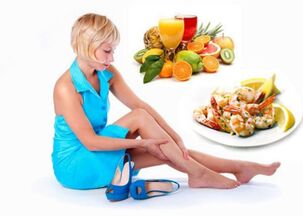
Nutrition, diet
Normalization of diet in the treatment of varicose veins is one of the basic requirements for a speedy recovery. To restore blood vessels, the body needs to receive vitamins and minerals, in order to strengthen the immune system.
When compiling a diet, the patient should be familiar with the list of foods that should not be eaten or, conversely, should be added to the diet:
| Allowed food and drink list | List of prohibited foods and beverages |
|
|
Despite certain dietary restrictions, there are many foods that are prepared from healthy foods.
Patients with varicose veins are advised to adhere to the following menu:
| Meal | Menu |
| Breakfast |
|
| Lunch |
|
| Lunch |
|
| Snack |
|
| Dinner |
|
Displays meal options that can be included in the diet. It must be borne in mind that you cannot eat a maximum of 250 grams. every dish. Dietary compliance will help normalize excess weight and improve the functioning of the circulatory system.
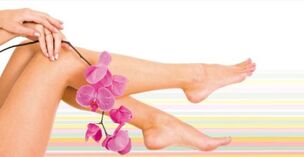
Prevention
To reduce the likelihood of developing varicose veins, you must adhere to the following recommendations:
- Give up bad habits.
- Control your weight.
- Do regular morning exercises, run several times a week, visit the pool.
- Reduce the likelihood of physical overexertion.
- Follow a proper diet, avoid constipation.
- Take tight tight clothes and uncomfortable shoes out of the closet.
- Combine vacation and work evenly.
- If the job requires prolonged standing or sitting, perform leg exercises.
- Stick to a proper daily routine, remove nervous tension.
Attention!
Prevention of varicose veins is necessary to slow down the progressive disease and prevent pathology in the future.
Reviews
My varicose veins started when I was 15 years old. As I later learned, the disease in our family is inherited. So I had to give up weightlifting and learn how to plan physical activity for my body. Once every 6 months, I use garlic ointment to control varicose veins. "
Age takes its toll. I encountered varicose veins 15 years ago. Like many, he missed the first stage of the disease, when it was possible to completely cure it. I now support varicose veins in 2 stages with the help of medicines and herbal tinctures.
I don't have varicose veins, but I regularly use tinctures and ointments against diseases, I adhere to preventive measures. Maybe that's why the disease hasn't caught me yet. A compress with honey is great for my wife.
Conclusion
Varicose veins are a disease that can affect men and women of all ages. There are many prescriptions from alternative medicine that can slow down or completely cure the pathology. The only condition is a mandatory appeal to the expert and coordination of all actions with him.












































